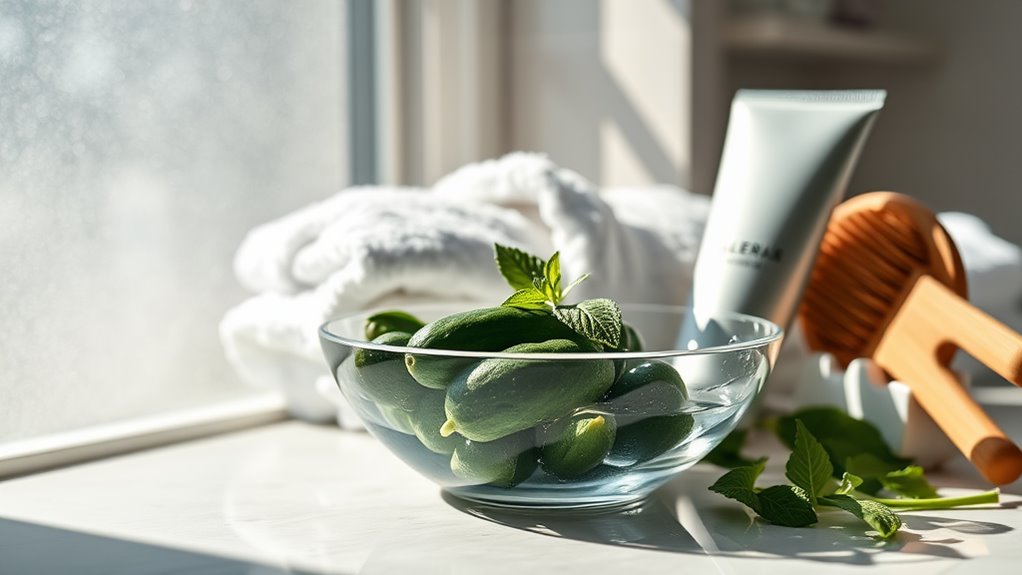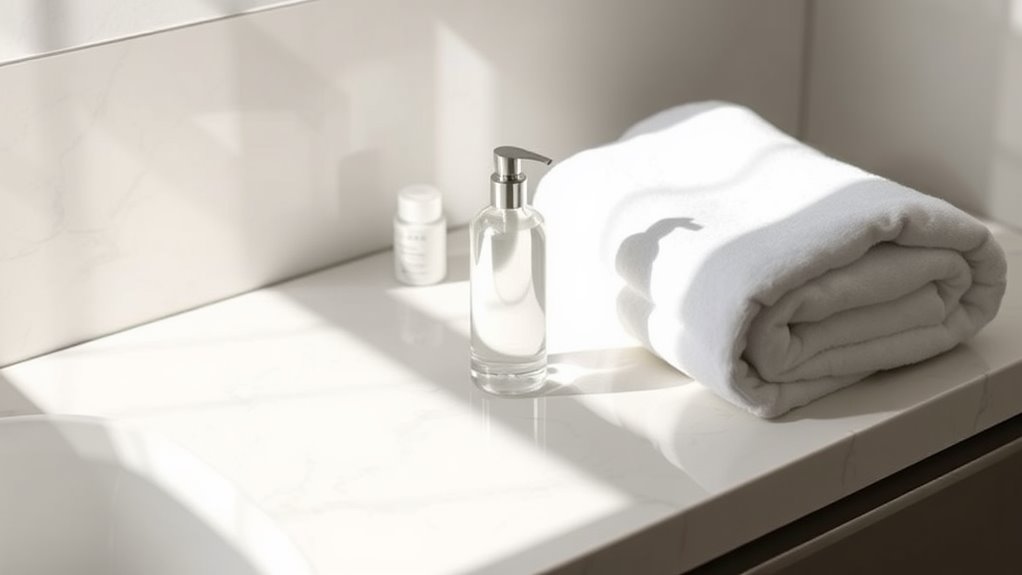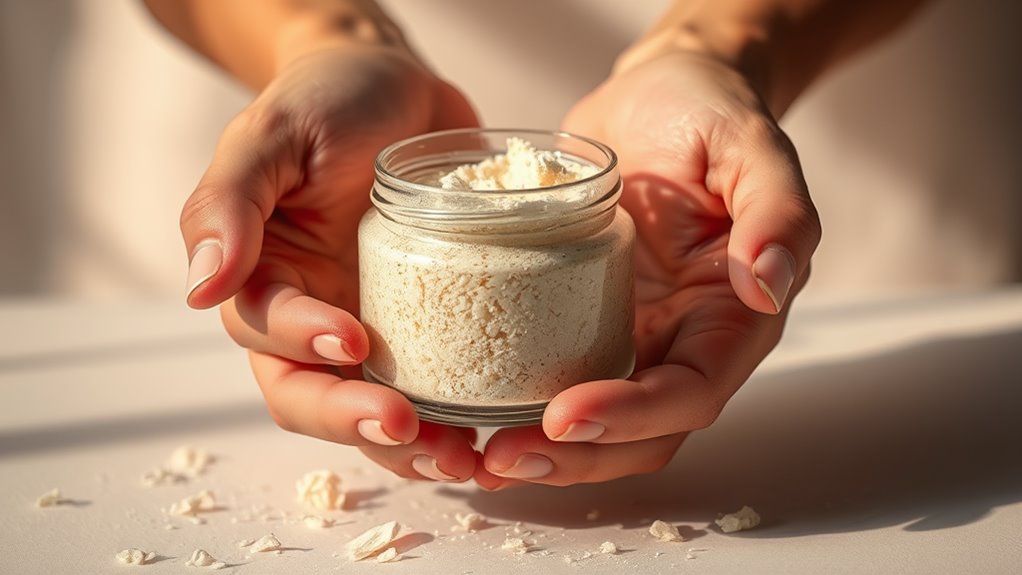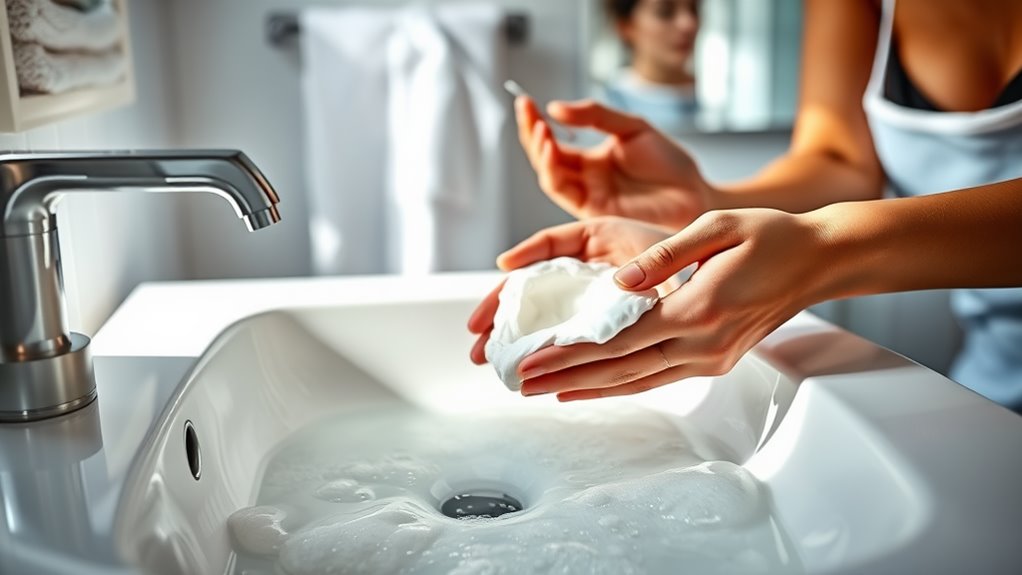The Best Way to Cleanse Skin Without Over-Drying It
To cleanse your skin without over-drying, start by identifying your skin type and choosing a gentle, hydrating cleanser. Look for products with a pH between 4.5 and 5.5 that won’t strip natural oils. Use lukewarm water and apply cleanser with your fingertips in light, circular motions. Rinse thoroughly and pat your skin dry. Incorporate hydrating ingredients like hyaluronic acid or glycerin, and follow up with a moisturizer to maintain hydration. There’s more to discover on preserving your skin’s moisture.
Key Takeaways
- Identify your skin type to choose a suitable, gentle cleanser that maintains moisture balance without stripping natural oils.
- Use lukewarm water for cleansing to avoid over-drying and protect your skin’s natural oils.
- Look for hydrating ingredients like hyaluronic acid and glycerin in your cleanser to enhance moisture retention.
- Cleanse twice daily with light, circular motions, and ensure thorough rinsing to prevent residue buildup and breakouts.
- Prioritize fragrance-free and hypoallergenic products to minimize irritation and protect your skin barrier.
Understanding Skin Types and Their Needs
How well do you know your skin type? Understanding your skin type is crucial for establishing an effective gentle cleansing routine.
There are four primary skin types: oily, dry, combination, and sensitive. Oily skin tends to produce excess sebum, requiring a cleansing routine that balances oil without stripping moisture.
Dry skin, on the other hand, needs hydration and protection, so a gentle, creamy cleanser is ideal.
Combination skin demands a tailored approach, focusing on both oily and dry areas.
Sensitive skin requires utmost care; choose fragrance-free, soothing cleansers to avoid irritation.
By identifying your skin type, you can customize your cleansing routine, ensuring you maintain optimal skin health without over-drying or causing irritation. Choosing the right cleanser is essential for achieving the best results.
Master this knowledge for lasting results.
Choosing the Right Cleanser for Your Skin
Choosing the right cleanser starts with identifying your skin type, as different formulas cater to specific needs. You’ll also want to be aware of ingredients that can irritate or harm your skin, ensuring you select a gentle yet effective option. Additionally, opt for products that prioritize hydration without over-drying, which can help maintain your skin’s moisture balance.
Identify Skin Type
Understanding your skin type is crucial for selecting the right cleanser, as different skin types require different care to maintain balance and health.
To identify your skin type, consider the following characteristics:
-
Oily: Shiny appearance with enlarged pores and frequent breakouts.
-
Dry: Flaky, rough texture with potential tightness and redness.
-
Combination: Oily in the T-zone (forehead, nose, chin) and dry or normal elsewhere.
-
Sensitive: Prone to redness, irritation, or allergic reactions.
-
Normal: Balanced, not too oily or dry, with minimal imperfections.
Ingredients to Avoid
When selecting a cleanser, it’s essential to recognize which ingredients to avoid, especially if you want to maintain your skin’s health and balance.
Steer clear of sulfates, as they can strip natural oils and lead to dryness. Alcohol-based products should also be avoided, as they can irritate and dehydrate your skin.
Fragrances, both synthetic and natural, can trigger sensitivities or allergies, so opt for fragrance-free options. Additionally, avoid harsh exfoliants like microbeads or physical scrubs that can damage the skin’s barrier.
Instead, look for gentle alternatives that prioritize hydration and soothing properties. By avoiding these ingredients, you’ll help ensure your skin remains balanced, healthy, and well-cared-for.
The Importance of Ph Balance in Cleansers
pH balance plays a crucial role in the effectiveness of skin cleansers, as it directly impacts how well your skin can maintain its natural barrier.
When your cleanser’s pH is too high or too low, it can disrupt this barrier, leading to irritation or dryness.
Consider these essential points about pH balance in cleansers:
- Optimal pH Range: Aim for a pH between 4.5 and 5.5 for best results.
- Skin Compatibility: A balanced pH aligns with your skin’s natural acidity.
- Barrier Function: Maintains moisture levels and protects against irritants.
- Microbiome Health: Supports beneficial bacteria that keep skin healthy.
- Preventing Over-Drying: Avoids stripping natural oils, ensuring hydration.
Understanding pH balance is key to selecting an effective cleanser that respects your skin’s needs. Additionally, using gentle cleansers can help maintain skin health, preventing irritation and supporting the skin barrier.
Techniques for Gentle Cleansing
Choosing a cleanser with the right pH balance is just the beginning; employing gentle techniques can further protect your skin’s integrity.
Start by using lukewarm water to avoid stripping the skin’s natural oils. Apply your cleanser with your fingertips, using light, circular motions—this minimizes irritation and enhances blood circulation. Avoid scrubbing; instead, let the cleanser do the work for you.
Rinse thoroughly, ensuring no residue remains, as this can lead to breakouts. Pat your skin dry with a soft towel rather than rubbing, which can cause micro-tears.
Finally, cleanse just twice daily—once in the morning and once before bed—to maintain your skin’s natural barrier while effectively removing impurities. Additionally, be aware that your facial cleanser can be too harsh if it contains sulfates or alcohol, which can strip the skin of its natural moisture.
Adopting these techniques will elevate your cleansing routine and promote healthier skin.
Incorporating Hydrating Ingredients
Incorporating hydrating ingredients into your cleansing routine can significantly enhance your skin’s moisture levels and overall health. By choosing the right products, you can maintain hydration while effectively removing impurities.
Look for ingredients that nourish and soothe your skin, such as:
- Hyaluronic Acid: Retains moisture, plumping the skin.
- Glycerin: Attracts water to the skin, preventing dryness.
- Aloe Vera: Calms irritation and adds hydration.
- Coconut Oil: Provides natural moisture while cleansing.
- Squalane: Mimics skin’s natural oils, locking in moisture.
Integrating these ingredients won’t only keep your skin balanced but also promote a radiant, healthy complexion. Additionally, understanding common misconceptions about moisturizers can further optimize your skincare routine for better hydration results.
Prioritizing hydration during cleansing is key to achieving optimal skin health.
The Role of Moisturizers After Cleansing
After cleansing, applying a moisturizer is crucial for restoring hydration to your skin.
It helps lock in moisture, preventing dryness and maintaining your skin’s barrier function.
When choosing the right formula, consider your skin type and specific needs to ensure optimal results.
Importance of Hydration
While cleansing your skin is essential for removing impurities, it’s equally important to follow up with proper hydration.
Moisturizers restore moisture lost during cleansing and help maintain your skin’s natural barrier. Without adequate hydration, your skin can become dry, irritated, and more susceptible to environmental damage.
Incorporating a moisturizer into your routine enhances your skin’s overall health and appearance.
- Balances oil production
- Reduces the appearance of fine lines
- Promotes a radiant complexion
- Protects against environmental stressors
- Supports skin barrier function
Choosing the Right Formula
Finding the right moisturizer can significantly impact your skin’s health following cleansing. After removing impurities, you need a formula that restores hydration without clogging pores.
Look for moisturizers containing hyaluronic acid, which attracts water, or glycerin, a powerful humectant. If your skin’s oily, opt for lightweight, oil-free gels that provide moisture without excess shine.
For dry skin, richer creams with ingredients like shea butter or ceramides can help lock in hydration. Always check for non-comedogenic labels to prevent breakouts.
Additionally, consider your skin type and any sensitivities; fragrance-free or hypoallergenic options are often best. By choosing wisely, you can maintain your skin’s barrier, ensuring it remains supple and radiant post-cleansing.
Tips for Maintaining Skin Hydration Throughout the Day
To keep your skin hydrated throughout the day, it’s essential to adopt a proactive approach.
Here are some effective tips to maintain that coveted moisture balance:
-
Drink Plenty of Water: Hydration starts from within; aim for at least eight glasses daily.
-
Use a Hydrating Mist****: Carry a facial mist to refresh your skin and lock in moisture.
-
Opt for a Humidifier: Especially in dry environments, a humidifier can add necessary moisture to the air.
-
Avoid Hot Showers: Hot water strips your skin of natural oils; stick to lukewarm temperatures.
-
Choose Moisturizing Products: Select creams and lotions with hyaluronic acid or glycerin for added hydration.




